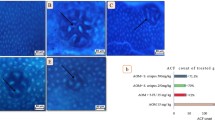Summary.
Background:
Onion and tomato are vegetables widely consumed by humans and epidemiological studies show an inverse association between vegetable consumption and colon cancer risk; however, the effect on colon cancer of diets containing high levels of vegetables like onion and tomato are not clear.
Aims of the study:
To investigate whether tomatoes and onions,with low or high quercetin-glycoside content, could reduce azoxymethane (AOM)-induced Aberrant Crypt Foci (ACF), preneoplastic lesions in the colon of rats.
Methods:
Male Fisher 344 rats were fed the following diets: a) high fat (HF) diet (control diet); b) HF diet containing 20 % (w/w) tomatoes with a low quercetin-glycoside content (final concentration in the diet: 5 mg/kg of quercetin aglycone equivalents); c) HF diet containing 20% (w/w) high quercetin-glycoside tomatoes (100 mg/kg final concentration of quercetin aglycone equivalents); d) HF diet containing 20 % (w/w) low quercetin-glycoside onions (14 mg/kg of quercetin aglycone equivalents in the diet); e) HF diet containing 20 % (w/w) high quercetin-glycoside onions (360 mg/kg quercetin aglycone equivalents in the diet). After 2 wks of feeding, all rats were treated twice, 1 wk apart, with AOM (12 mg/kg, s. c.). The dietary treatments continued until sacrifice, 7 wks after the first injection with AOM.
Results:
ACF induction did not vary in animals fed low or high quercetin-glycoside tomatoes relative to controls. On the contrary, rats fed 20% (w/w) onion-based diets, with low or high quercetin-glycoside content, showed an increase in number, multiplicity and “large” ACF compared to the control group (number of ACF/colon 145 ± 15 (SE), 255 ± 11 and 218 ± 16 in controls, low and high-quercetin-glycoside groups, respectively; p < 0.01). Proliferative activity of the colon did not vary between animals fed control and high quercetin-glycoside tomato diet. The height of the crypts in normal mucosa of rats fed high quercetinglycoside onions was significantly increased compared to control rats (cells/emicrypt 38.4 ± 1.2 (SE) and 41.3 ± 0.6 in controls and high quercetin-glycoside onions group, p < 0.05).
Conclusions:
None of the diets supplemented with onion or tomato with variable quercetin-glycoside content demonstrated a potential chemopreventive effect on ACF-induction by AOM in rats.
Similar content being viewed by others
Author information
Authors and Affiliations
Corresponding author
Rights and permissions
About this article
Cite this article
Femia, A.P., Caderni, G., Ianni, M. et al. Effect of diets fortified with tomatoes or onions with variable quercetin-glycoside content on azoxymethane-induced aberrant crypt foci in the colon of rats. Eur J Nutr 42, 346–352 (2003). https://doi.org/10.1007/s00394-003-0431-5
Received:
Accepted:
Issue Date:
DOI: https://doi.org/10.1007/s00394-003-0431-5




